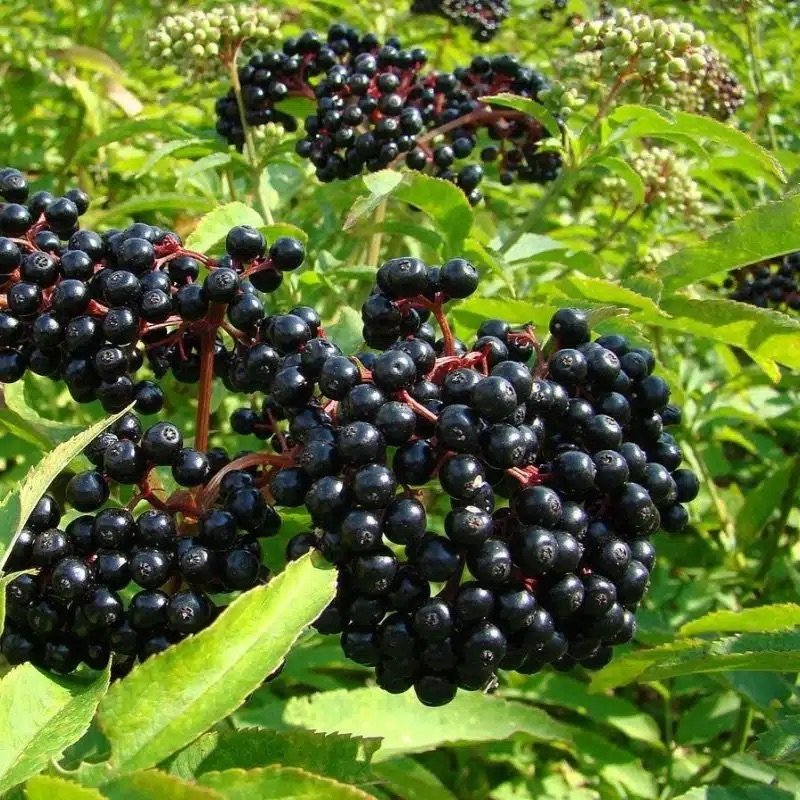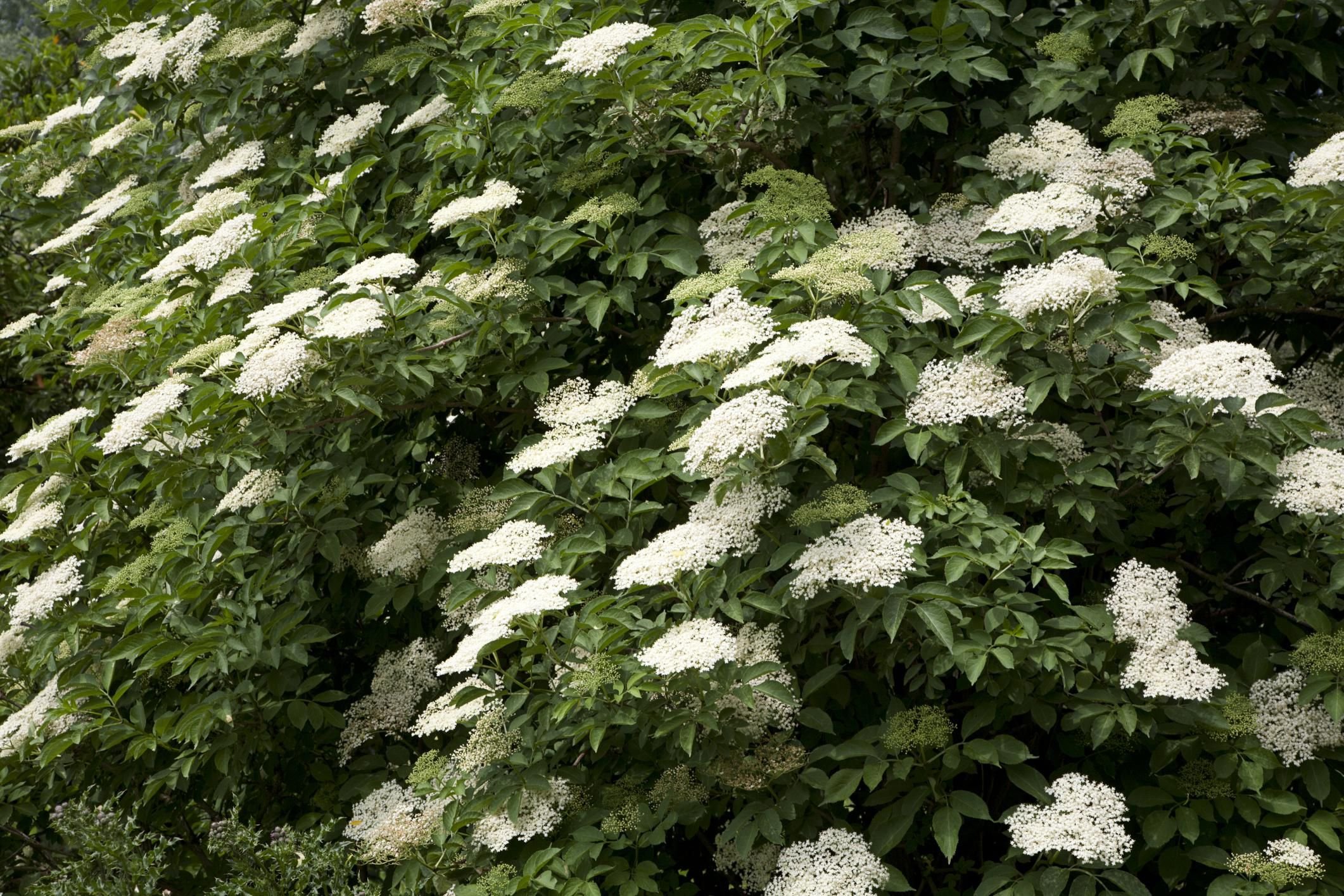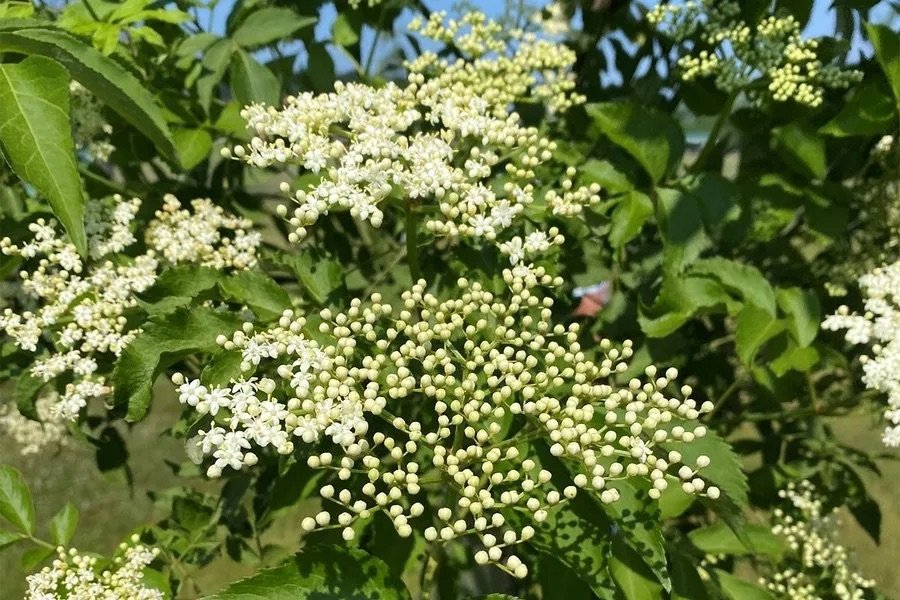Elderberry
Sambucus spp. Elderberry is a deciduous, woody, multistemmed plant growing either as a clump-like shrub or small tree from 5-8 FT tall and equal spread. It is an attractive, deer-resistant plant with an upright and rounded shape that often spreads by root suckers and will form thickets. It prefers wet, well-drained soils and will grow in full sun or part shade. The plant has yellowish-white flowers that grow in flat-topped clusters. The dark purple, rounded fruits, called drupes, ripen in August and September and are attractive to wildlife. Foliage turns red in the fall.
Best to let the fruit ripen on the shrub before picking if the birds don’t get them first. When harvesting, prune off the entire fruit cluster and then strip the berries into a large bowl or bucket. Berries do not keep well at room temperature, keep refrigerated-and process them as soon as possible. Two varieties needed for best pollination and you can mix and match any of the varieties listed
canadensis : straight species, grown from wild sourced cuttings, fruiting characteristics and quality are unknown.
Wyldewood : Huge flower heads-up to 12" across-produce high yields of small, sweet, dark purple fruit in the late-summer months. This is a great variety for making wine and jam. An excellent source of vitamin C. Bears fruit in 2-3 years.
York : Developed as part of an experiment by the New York Agriculture Experiment Station in 1964. A cross between the Adams No. 2 and the Ezyoff, both large crop producers. Known as a prolific producer.
Scotia (cuttings) : Scotia was developed at the Kentville AAFC Research and Development Centre in Nova Scotia. It is a seedling of another variety, Adams 2, and was released by the research station in 1960, alongside the variety Nova. Berries ripen early in the season and have the highest sugar content of any named cultivar- though also some of the smallest berries
Sold as bare root plants 12-24” tall or cuttings.
Sambucus spp. Elderberry is a deciduous, woody, multistemmed plant growing either as a clump-like shrub or small tree from 5-8 FT tall and equal spread. It is an attractive, deer-resistant plant with an upright and rounded shape that often spreads by root suckers and will form thickets. It prefers wet, well-drained soils and will grow in full sun or part shade. The plant has yellowish-white flowers that grow in flat-topped clusters. The dark purple, rounded fruits, called drupes, ripen in August and September and are attractive to wildlife. Foliage turns red in the fall.
Best to let the fruit ripen on the shrub before picking if the birds don’t get them first. When harvesting, prune off the entire fruit cluster and then strip the berries into a large bowl or bucket. Berries do not keep well at room temperature, keep refrigerated-and process them as soon as possible. Two varieties needed for best pollination and you can mix and match any of the varieties listed
canadensis : straight species, grown from wild sourced cuttings, fruiting characteristics and quality are unknown.
Wyldewood : Huge flower heads-up to 12" across-produce high yields of small, sweet, dark purple fruit in the late-summer months. This is a great variety for making wine and jam. An excellent source of vitamin C. Bears fruit in 2-3 years.
York : Developed as part of an experiment by the New York Agriculture Experiment Station in 1964. A cross between the Adams No. 2 and the Ezyoff, both large crop producers. Known as a prolific producer.
Scotia (cuttings) : Scotia was developed at the Kentville AAFC Research and Development Centre in Nova Scotia. It is a seedling of another variety, Adams 2, and was released by the research station in 1960, alongside the variety Nova. Berries ripen early in the season and have the highest sugar content of any named cultivar- though also some of the smallest berries
Sold as bare root plants 12-24” tall or cuttings.
Sambucus spp. Elderberry is a deciduous, woody, multistemmed plant growing either as a clump-like shrub or small tree from 5-8 FT tall and equal spread. It is an attractive, deer-resistant plant with an upright and rounded shape that often spreads by root suckers and will form thickets. It prefers wet, well-drained soils and will grow in full sun or part shade. The plant has yellowish-white flowers that grow in flat-topped clusters. The dark purple, rounded fruits, called drupes, ripen in August and September and are attractive to wildlife. Foliage turns red in the fall.
Best to let the fruit ripen on the shrub before picking if the birds don’t get them first. When harvesting, prune off the entire fruit cluster and then strip the berries into a large bowl or bucket. Berries do not keep well at room temperature, keep refrigerated-and process them as soon as possible. Two varieties needed for best pollination and you can mix and match any of the varieties listed
canadensis : straight species, grown from wild sourced cuttings, fruiting characteristics and quality are unknown.
Wyldewood : Huge flower heads-up to 12" across-produce high yields of small, sweet, dark purple fruit in the late-summer months. This is a great variety for making wine and jam. An excellent source of vitamin C. Bears fruit in 2-3 years.
York : Developed as part of an experiment by the New York Agriculture Experiment Station in 1964. A cross between the Adams No. 2 and the Ezyoff, both large crop producers. Known as a prolific producer.
Scotia (cuttings) : Scotia was developed at the Kentville AAFC Research and Development Centre in Nova Scotia. It is a seedling of another variety, Adams 2, and was released by the research station in 1960, alongside the variety Nova. Berries ripen early in the season and have the highest sugar content of any named cultivar- though also some of the smallest berries
Sold as bare root plants 12-24” tall or cuttings.




